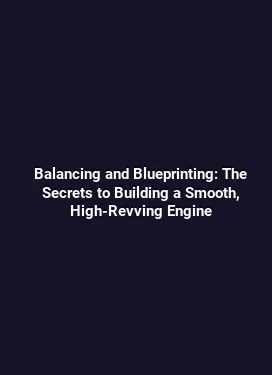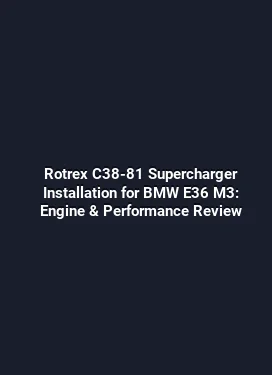How to Install Tial MVS 38mm Wastegate on Honda S2000 F20C Engine
Product fitment and system overview

The Tial MVS 38mm wastegate is a compact, precision-controlled boost control device designed to manage exhaust flow from a turbocharger, keeping boost levels within the desired range. When paired with a Honda S2000 running the F20C engine, this wastegate provides consistent spring pressure and stable boost response, especially in high-load or track conditions. The 38mm diameter offers a balance between quick boost control and the capacity needed for moderate to high-power builds. Key considerations for compatibility include the turbocharger size, exhaust manifold design, and the routing of the wastegate’s external flanges and vacuum or electronic control lines. Effective usage also demands attention to the intake piping, intercooler layout, and the mounting surface around the turbocharger area to avoid heat soak and vibration transfer. In this installation, the emphasis is on accurate mounting, reliable vacuum reference, and proper exhaust flow management. The MVS (Monoterm Vacuum Solenoid) unit is designed to deliver repeatable pressure control through a robust diaphragm system, while the 38mm aperture provides a suitable breach point for higher boost targets without creating excessive backpressure that could hinder spool time. Practically, the goal is to maintain consistent boost pressure across RPMs while preventing over-boost conditions that could stress the engine’s internals. This requires careful attention to the wastegate’s actuator rod alignment, mounting studs, and the recommended heat-resistant coatings for the surrounding turbo manifold area.
Technical prerequisites and compatibility considerations
Before starting the installation, verify engine and turbo compatibility. The S2000’s F20C engine uses a compact, high-revving design that benefits from efficient wastegate routing and heat management. Ensure the following prerequisites are met: - A compatible turbocharger with a wastegate flange and proper porting that matches the 38mm diameter. - A robust, heat-treated mounting surface on the turbo housing to prevent warping or stud pullout. - A secure vacuum or electronic control line routing path with minimal risk of interference from piping, fuel rails, or sensor harnesses. - Adequate space around the exhaust manifold area to accommodate the wastegate body, actuator, and mounting hardware without contacting adjacent components. - A reliable pressure source for the wastegate actuator, whether vacuum or electronic, with a clean, leak-free line. The F20C is known for its high intake velocities and compact layout. It is important to maintain adequate clearance near the water pump, alternator, and timing belt covers to avoid heat transfer and mechanical interference. Choosing the right hardware—stainless steel studs, high-temperature gaskets, and lock washers—will minimize vibration-related looseness at high RPMs.
Required tools and preparation
Some of the essential tools for a clean and reliable installation include: - Metric torque wrench with a range suitable for automotive fasteners (up to 80 Nm or more). - Deep socket set (including 6 mm to 12 mm sizes for securing flanges and mounting hardware). - Allen keys or hex wrenches for actuator mounting. - Wrenches or a ratchet with appropriate extensions for accessing tight spaces. - Calibrated vacuum gauge or a suitable pressure regulator if using a vacuum-operated actuator. - A torque-rated thread sealant or gasket maker compatible with exhaust and turbo components. - Anti-seize compound for stainless fasteners to ease future service. - Heat-resistant shield material or heat wrap for protecting nearby pipes and hoses. Careful preparation also includes cleaning all mating surfaces, verifying gaskets are in good condition, and ensuring the wastegate’s porting is smooth and free of burrs. A clean, lint-free workspace reduces the risk of debris entering the turbocharger or exhaust paths during installation.
Mounting hardware and flange alignment
Install the wastegate using the provided mounting kit. Begin by checking flange alignment with the turbocharger outlet. Misalignment can cause leaks or warped mating surfaces that degrade boost control. The following steps help maintain precise alignment: - Place a thin copper or graphite gasket between the wastegate flange and the turbo outlet to ensure a precise seal. - Lightly snug the mounting bolts to hold the wastegate in place, then check for proper alignment by visually inspecting the flange faces. - Tighten bolts in a cross pattern to distribute load evenly, using a torque specification recommended by the wastegate manufacturer. Avoid over-tightening, which can crack the flange or warp the outlet. - Verify there is no interference with nearby coolant lines, sensor wiring, or the exhaust manifold studs. Mounting orientation is critical for consistent actuator leverage. The actuator should sit in a position where its pushrod aligns with the diaphragm arm without bending, ensuring smooth operation as boost pressure changes. If the actuator requires a specific angle, adjust mounting brackets accordingly in small increments to preserve proper travel and avoid binding.
Piping and vacuum line routing

Efficient routing of the wastegate’s vacuum line is essential for stable boost control. The line should be as short as possible, with minimal bends to reduce pressure drop. Use heat-resistant hose or braided lines designed for automotive use. Maintain a straight path away from hot exhaust components to prevent line collapse or degradation. For electronic boost control setups, ensure compatible wiring harnesses and controllers are shielded from high-temperature zones and EMI interference. In vacuum-operated systems, a clean, dry vacuum source is critical. Any leak in the line dilutes the reference signal, causing flutter, boost creep, or unpredictable spiking. A simple, reliable test is to seal the system and inspect for a consistent pressure hold under static conditions. If you notice a loss of vacuum, re-check line connections, grommets, and the integrity of the actuator seal.
Installation steps: a practical, step-by-step workflow
With all preparation complete, follow these detailed steps to install the Tial MVS 38mm wastegate on the Honda S2000’s F20C engine. Each step emphasizes precise measurement, clean surfaces, and verification checks to ensure long-term reliability and performance. 1) Disconnect the battery and double-check safe working conditions. Remove any obstructions around the turbo area that could interfere with the wastegate installation. 2) Inspect the turbo outlet flange and gather the wastegate mounting hardware. Ensure all bolts and gaskets are clean and free of debris. 3) Position the wastegate flange against the turbo outlet. Lightly place the gasket, then insert mounting bolts. Do not torque yet; verify alignment visually. 4) Tighten bolts in a cross pattern to the manufacturer’s torque specification. Recheck the alignment after initial torque to confirm there is no wobble or misfit. 5) Attach the wastegate actuator end to its bracket or support. Ensure there is a straight path for the pushrod. If the actuator plating or bracket requires modification for fitment, perform adjustments conservatively. 6) Route the vacuum or electronic control line from the wastegate to its reference source. Secure the line with clamps away from hot surfaces, sharp edges, and moving components. 7) Install a heat shield or wrap around the wastegate area if heat exposure from the exhaust manifold or turbine housing is excessive. This extension helps preserve line integrity and reduces heat soak in nearby sensors and hoses. 8) Confirm clearance with adjacent components (oil lines, coolant lines, wiring harnesses). Ensure there is no contact that could cause chafing or wear. 9) Reconnect the battery, then perform a leak test. Pressurize the system gradually to check for any leaks at the wastegate flange and line connections. Address leaks as necessary. 10) Conduct a functional test by applying a controlled vacuum or feeding the electronic signal to the actuator. Observe the wastegate’s response and confirm that the disc opens smoothly in response to the control input.
Calibration and initial tuning considerations
After physical installation, tuning the boost control system is crucial for achieving reliable performance without risking engine damage. If you’re using a combined boost controller or a dedicated ECU, the following practical steps help achieve a stable baseline: - Establish a conservative base boost target that aligns with the engine’s compression ratio and fuel system capabilities. A conservative initial target reduces the risk of over-boost under sudden throttle changes or gear shifts. - Verify the boost curve across the RPM range. A smooth, predictable rise in boost with RPM is preferable to abrupt spikes. If a spike occurs, check for vacuum leaks, line length mismatches, or actuator binding. - Ensure the wastegate opens at the expected boost level by performing a controlled pull or dyno test. If the opening point deviates, adjust the reference pressure or recalibrate the electronic controller to match the target MAP (manifold absolute pressure). - Cross-check with data logging, focusing on AFR (air-fuel ratio), RPM, manifold pressure, and boost target. Small shifts in AFR can indicate the need for fuel system adjustment or ignition timing changes to accommodate the added boost. - Plan for safety margins by incorporating a boost cut or conservative limit in the ECU to prevent sustained over-boost conditions under extreme load scenarios.
Performance implications and real-world expectations
Implementing a 38mm wastegate on the Honda S2000 can lead to measurable improvements in boost stability and response time. Several practical outcomes to anticipate include: - More controlled boost delivery during shifts, track corners, or rapid throttle changes. The wastegate’s precise discharge path reduces boost fluctuation and lift-off spikes. - Enhanced spool behavior on moderately boosted builds. The larger aperture helps manage exhaust flow without excessive backpressure, aiding spool times for certain turbo configurations. - Improved durability under sustained high-load conditions. A well-mounted wastegate with proper heat management reduces the risk of pre-ignition caused by boost instability. On the other hand, it’s essential to maintain a balanced approach: inappropriate sizing, poor vacuum reference, or misrouting of lines can negate gains and introduce lag or boost creep. Strive for a holistic setup that considers the exhaust manifold design, intercooling efficiency, fuel delivery capacity, and ignition timing strategy. Real-world testing, including track sessions or dyno runs, will reveal how well the wastegate integrates with the vehicle’s overall powertrain behavior.
Maintenance, troubleshooting, and longevity
Maintenance routines ensure the wastegate continues to perform consistently over time. Practical tips include: - Regular inspection of the wastegate body, flange gasket, and actuator for signs of wear, corrosion, or heat damage. Replace worn gaskets promptly to prevent leaks. - Periodic checks of vacuum lines for cracks, stiffness, or loose connections. Replace any lines showing signs of aging. - Confirm that mounting hardware remains torqued to specification. Vibration from aggressive driving can gradually loosen fasteners, so perform a routine check after the first few long sessions and at regular intervals thereafter. - Keep heat shields intact and inspect them for deformation. Excessive heat can degrade hoses and nearby components, so ensure shielding remains effective. If a maintenance issue arises, address it with a methodical approach: isolate the cause (vacuum line, actuator, or gasket), repair or replace the faulty part, and re-test the system before resuming driving.
Summary of practical tips for reliable operation
To maximize reliability and performance when installing the Tial MVS 38mm wastegate on an S2000 with the F20C engine, consider these practical recommendations: - Prioritize clean, straight vacuum line routing with minimal bends and secure clamping to prevent line movement. - Use quality, heat-resistant materials for all lines near the turbine housing to minimize degradation from high temperatures. - Verify gasket integrity and flange flatness to avoid boost leaks that could derail calibration. - Implement a robust data logging strategy to monitor boost, AFR, and ignition timing, enabling quick adjustments if needed. - Schedule periodic inspections to ensure mounting hardware remains tight and aligned as the system experiences vibration and engine heat cycling.






